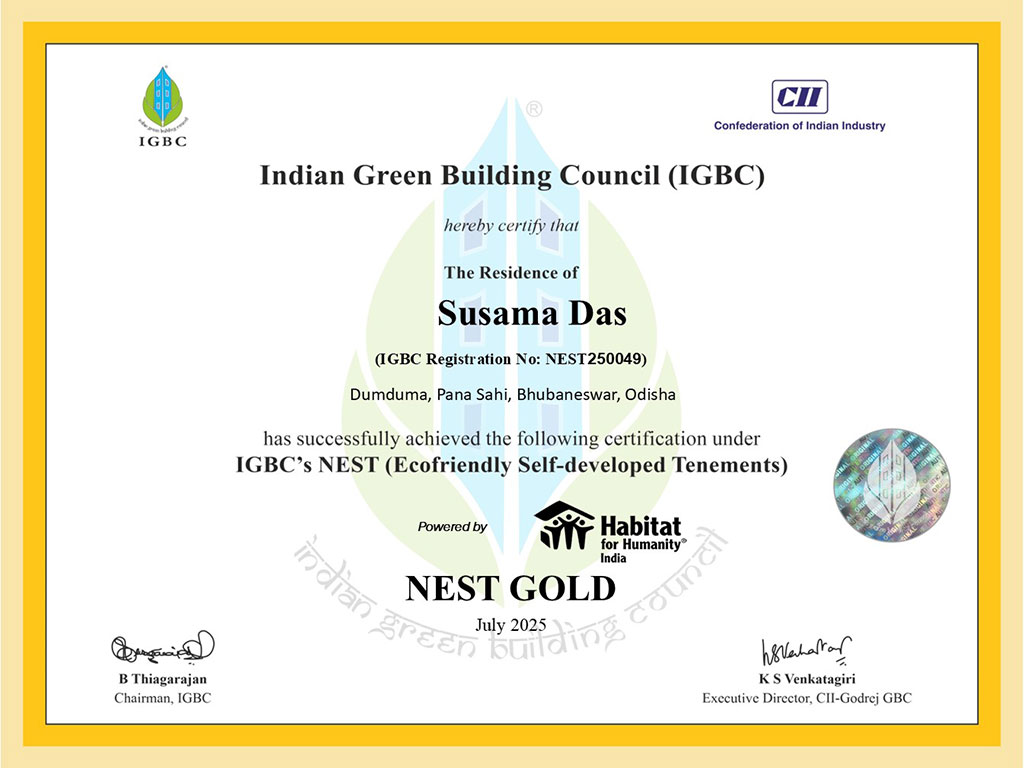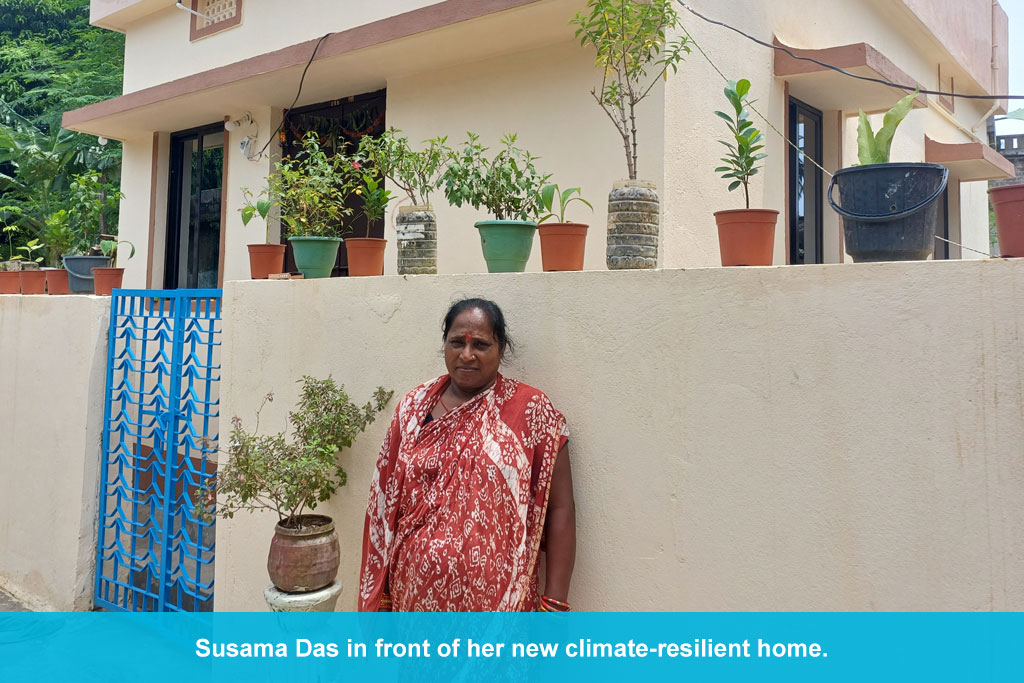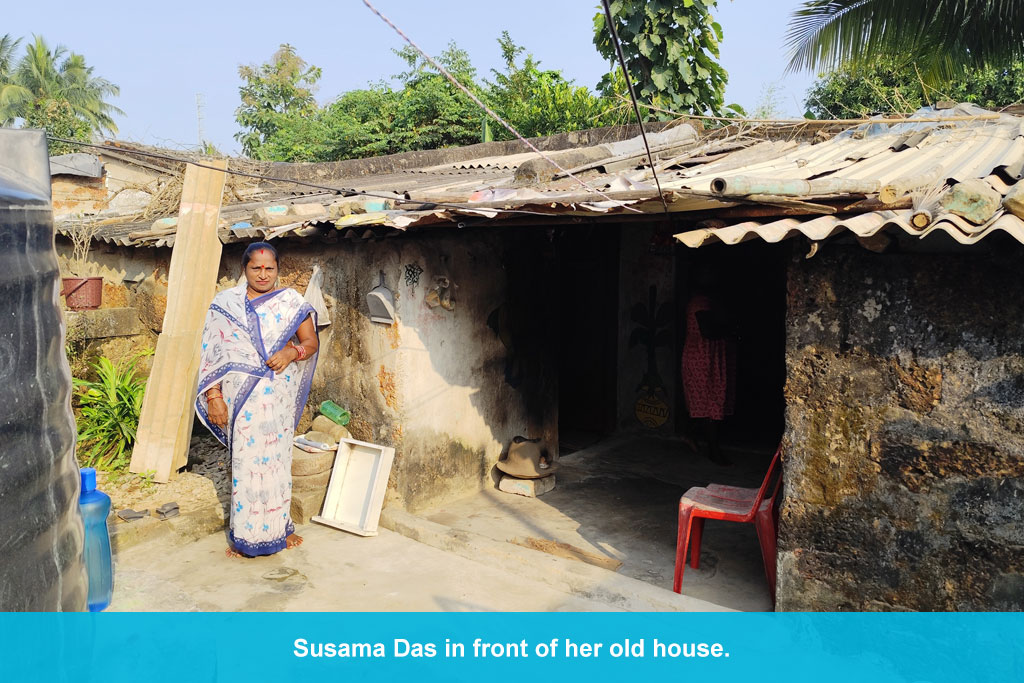Simanchal Das stands at the door of his new home with his wife Susama. Together, they look at the narrow street that used to flood every monsoon, filling their old hut with water. The couple, both in their fifties work as daily-wage labourers and live with their youngest of the three daughters. “Every time it rained, we were scared that our house would break,” says Simanchal.
“My earliest memory of entering this house is as a bride and I remember the roof being so low, I had to bend to get inside the house,” shares Susama. Their old house was made of mud, clay and scrap tin. The cracked walls let in wind. Rainwater came in easily and turned the mud floor soft and slippery. “We had to move our bedding and utensils again and again,” says Susama.
Sometimes snakes entered through the broken walls. There was no toilet inside the house, so they had to go outside even at night or in the rain.
Simanchal often walked long distances to find work at construction sites. He earned ₹500 - ₹600 a day. It was just enough to buy food. They could not afford to repair their house. Over time, Simanchal’s eyesight and hearing became weak. This made it harder for him to get work. “If we missed even one day of work, we had no food,” says Susama.
At a time when repairs seemed impossible, three vulnerable families including Susama’s family were supported by Habitat for Humanity India to build climate-resilient homes that were not only safe and strong but also sustainable.
During the selection process, Simanchal remembers sharing his concerns with the Habitat India team. “We told them that if a proper home is built, we will never have to worry about the water entering our homes or sleeping on wet floors. That is all. I was very happy when we were selected. It feels like it was Lord Jagannath’s blessing,” Simanchal shares.
“The water doesn’t come in anymore,” says Susama. The house has plinths to avoid flooding, solar panels for clean energy and a proper kitchen where I can now cook without smoke filling the room and water creeping under her feet. “We feel safe and secure in every season. The worry is gone,” she says. “When we were first told that a new home would be built for us, it was hard to believe,” Susama shares. “Even our neighbours were skeptical and wondered if it could really happen for people like us. Today, our dream has come true. There are many families in our neighbourhood who still need safe housing. I hope Habitat for Humanity will one day help them too.”
The home also includes rainwater harvesting, thermal insulation and systems to manage water and waste efficiently, all part of a thoughtful design that keeps the family comfortable and reduces the environmental impact of the home. The new house is also equipped with a sanitation unit.
Susama’s eldest daughter Sarojini is married and lives in Cuttack with her husband. The middle daughter Laxmipriya also lives with them and works in a garment shop. The youngest daughter Binodini has just finished her 12th exams and is now taking computer classes. She hopes to begin her bachelor’s degree soon. “I am most excited about the terrace we have at our new home,” she says.
The family performed their Grihapravesh puja (housewarming ceremony) during auspicious Rath Yatra festival, welcoming the idols of Lord Jagannath to their new home. “Earlier, there was no dry place to keep the idol. This time, we lighted Diyas on the kitchen counter,” says Susama.
The daughters have even picked colours: pink and green to paint their rooms. “We saw colourful houses on TV and thought why not ours?” says Binodini.
The street outside still floods sometimes, but the Das family is no longer afraid. From their doorstep, they watch the rain without worry. “Earlier, one big storm could destroy everything. Now when it rains, we sleep peacefully knowing the walls will hold,” says Simanchal.
The project introduced green construction technologies to build safe, sustainable homes for families vulnerable to floods and climate risks.
Each home includes features such as raised plinths to protect against flooding, solar panels for clean, reliable energy, rainwater harvesting systems, water and waste management solutions and thermal insulation for comfort in all seasons.
All three homes have been awarded the ‘NEST GOLD' (IGBC NEST) rating by Indian Green Building Council, recognising Habitat for Humanity’s commitment to sustainable, affordable and climate-resilient housing. 'IGBC NEST' is a first-of-its-kind eco-friendly, self-developed framework and certification that aims to bring awareness and drive the individual owners to build a sustainable home with no or meager additional cost.

The IGBC NEST certification involved multiple stages, beginning with project registration and the submission of detailed technical documentation, including architectural drawings, calculations and photographs. The homes were then evaluated by IGBC’s technical team. Based on the total credits earned across categories such as site selection, water efficiency, energy efficiency and indoor environmental quality, the homes received the prestigious gold rating.
These certified homes now stand as model examples of green housing at the individual household level. They demonstrate that sustainability is achievable even in small-scale, affordable housing projects, paving the way for the wider adoption of green building practices among vulnerable communities in Odisha and beyond.




